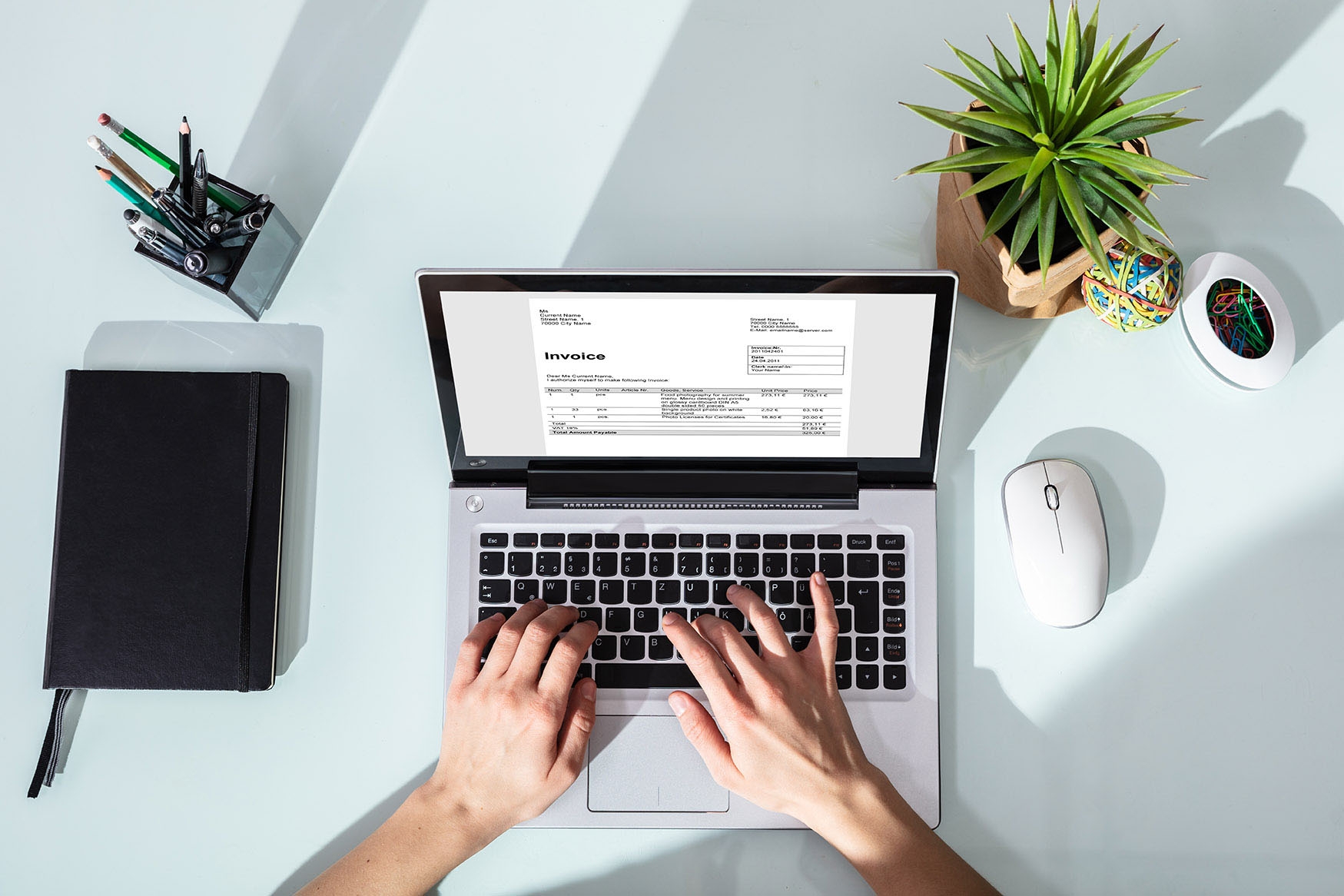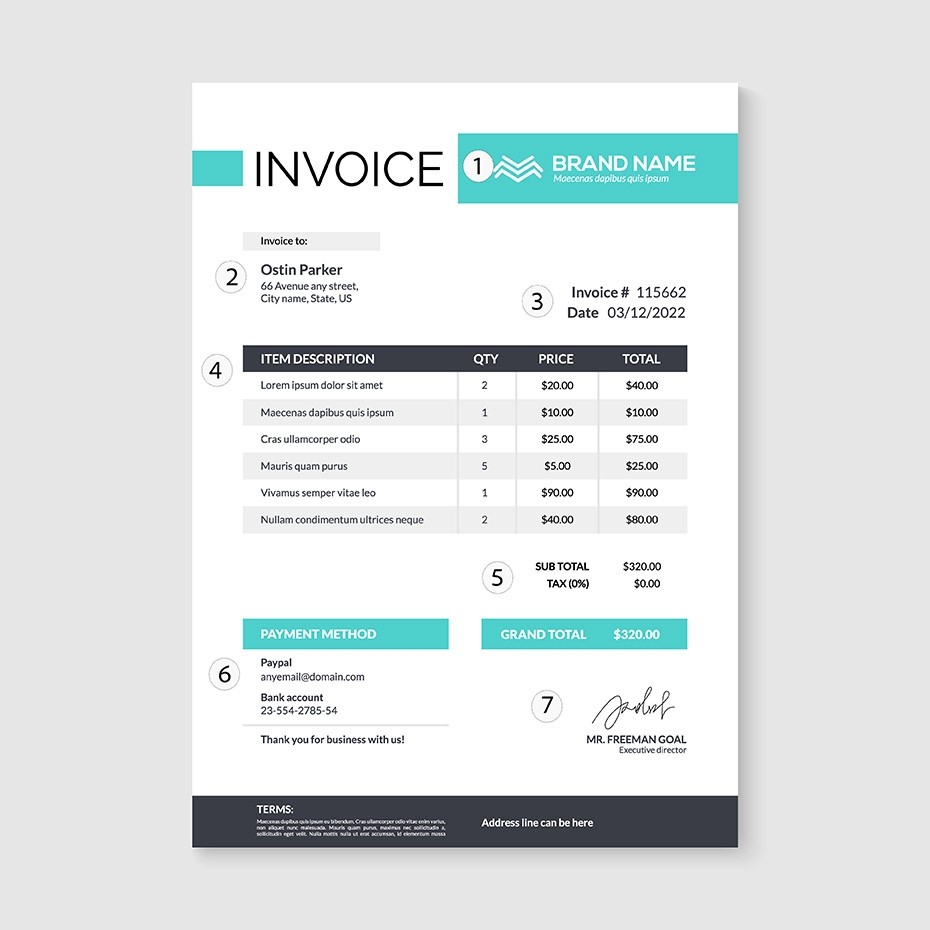
What you’ll learn:
- What is an invoice?
- Who uses invoices?
- Types of invoice
- Why do you need invoices?
- What needs to be present on an invoice?
- Invoice example template
Businesses, big and small, are built on documents. They keep everything running smoothly from one week to the next. Of all these documents, invoices are probably the most important – especially if you’re a sole trader, freelancer or small business owner.
An invoice ensures you get paid for your work – whether that’s artwork you sell in your online shop or a photography job you’ve just taken on. Whatever you do, invoices are essential to getting paid.
What is an invoice?
An invoice is a document sent by a seller to a buyer, asking for payment in return for their products or services. It should include the number of products or services provided, as well as the costs for each.
Invoices form a written agreement between the two parties, in which the buyer is obligated to pay the seller by a set date. They’re different to receipts, which are usually given after a payment has been made, as confirmation.
It’s important to keep a record of any invoices you send out, so you can track any late payments and correctly declare your taxable income.
Who uses invoices?

Invoices are mostly used by small business owners and the self-employed, who may not necessarily have the demands or resources of a big company when it comes to requesting money from clients.
If you make stuff and sell it, or are paid for services you provide to clients, like gardening or painting and decorating, then you’ll likely need to use invoices.
Some common examples include:
- Retailer. If you sell goods online or supply bulk items to businesses, you may use invoices to keep track of inventory and for bookkeeping.
- Freelancer. Many freelancers work on multiple projects, whether they’re a writer or a designer. Invoices help to keep a record of any work conducted and the payments due.
- Sole trader. When sending goods or services, it’s important sole traders send an invoice to inform the client how and when to pay, including the costs and any VAT, if applicable.
- Small business owner. Small business owners can use invoices to request money from clients.
Types of invoice?
There are several types of invoice. The correct invoice for your business will depend on what stage of the purchase your client is at, the type of product or services provided and the size and stature of your business.
Here’s a breakdown of the most common types:
- Standard invoice. A simple billing document sent by a seller to the buyer. This is the most flexible invoice, working for most industries and payment types.
- VAT invoice. Only needed if both your business and the seller is VAT registered. Works the same as a standard invoice, but with a breakdown of costs both with and without VAT.
- Proforma invoice. For big purchases, a client may ask for an invoice before the goods or services have been delivered. This works as an estimation of costs, rather than an official bill.
- Interim invoice. For multiple sets of products or big projects, an interim invoice can help you get paid for your work along the way. Once you reach a certain target, you can ask for payment for the work so far.
- Electronic invoice (e-invoice). This is a standard invoice reworked for the digital world. It should eliminate the need for paper copies, with data security and digital signatures.
- Revised invoice. Sometimes mistakes happen. You may need to send out a revised invoice to a client. For this, amend the date and add an “R” after the invoice number to avoid confusion.
Why do you need invoices

The main reason you need an invoice, is to bill your clients and get paid for your work. If you don’t invoice your clients, there’s less of a paper trail to demand payment, if someone tries to avoid paying you what you’re owed.
Records
Creating an invoice provides the perfect document to record what’s been sold, when it was delivered and how much money is owed.
Once all your invoices are collated in one place, it can also provide a snapshot of your business’ finances, including what products or services are most profitable.
If you have multiple employees, it can help to include who made the sale, to identify your star performers bringing in the most revenue.
Tax
Whether you’re a sole trader starting an empire from your spare room or you already employ a team of workers, every business is responsible for completing a tax return form every year. Invoices can simply speed up this process by having a record of all your sales and income in one place.
In some cases, HM Revenue & Customs (HMRC) may ask for evidence of your declared income. When this happens, invoices are the easiest way to show your taxable income and VAT records. Received invoices can also be useful to show any business expenses.
Legal protection
Invoices form a legal obligation between you and a client. If they refuse to pay for your services or goods, or file a lawsuit against you for missing work, invoices can help you build your case.
This is because a professional invoice should include all the details around what has been delivered and the timeline to completion, which was agreed by both parties.
Inventory
If you’re selling physical products, from handmade bracelets to bags of coffee, it’s important to keep an inventory so you know just how much product you have to sell, and when you need to order more.
Marketing
By looking back at past sales, you can begin to identify trends in your client demands at certain points of the year.
For example, you’re an office supplier and have one client who orders a huge batch of paper at the end of summer. You can use this data to target that client with a branded email or social advert at the right moment, then focus your marketing resources elsewhere through the rest of the year.
What needs to be present on an invoice?

Several components go into making an invoice professional and secure. These help to minimize delays in getting your payment and should include:
- Your business details. Include your name, address and contact details as well as any branded logo.
- The client. Add who the invoice is for, including the client’s full name and contact details.
- Invoice number. This should be unique to each invoice and follow a numbered pattern so it can be easily found in your records.
- Invoice date. The date you created this invoice.
- Product description. List all the products or services provided with a small description of each.
- Product costs. Mark the cost for each individual product/service.
- Total costs. At the bottom of your product details, include a total cost with and without VAT (if applicable).
- Payment details. Note the bank details the payment should be sent to. Be sure to add a date of when the payment is due.
Invoice example template
Most invoices follow a similar structure, so once you’ve mastered the components of one invoice, you can use it in the future. Creating a digital template can help streamline this process even further.

- Brand name, logo and address.
- Client name and address.
- Unique invoice number and the date the invoice was issued.
- The work completed, including quantities and costs.
- The total costs, including without VAT, with VAT and total amount to pay.
- Your bank details and payment due date.
- Your name, signature and role.
How to number invoices
Duplication is one of the biggest mistakes businesses can make when sending an invoice, with 3 in 5 companies saying they’ve received a duplicate invoice from their suppliers.
Invoice numbers can help prevent this and any other delays in your payment. There’s no set way to number your invoices. However, it’s important that the string of numbers or letters you choose follows a pattern.
For example, you could choose to have the first three letters of your brand, such as ADO, followed by the issue number, like 00001. The next invoice you send would then become ADO00002 and so on.
Some businesses prefer to include a date, such as 2021-03-001, while others use customer initials instead, to group purchases together.
How to send an invoice

The easiest and fastest way to ensure your invoice reaches the right person is to send an e-invoice, yet only 43% of companies receive their invoices electronically.
Use Adobe Acrobat to easily create invoices as a PDF, send directly to your client’s inbox in minutes, and collect their electronic signature – all in one handy location.
You can also track when your invoice has been signed and follow up with clients yet to view the file. Once an invoice is complete, it’ll be automatically stored in your secure records.
So now you know everything there is to know about invoices you can focus on building your business. Whether it’s selling your art online, trimming hedges outdoors or selling any other type of product of service.
Are you an aspiring business owner? Inspiring entrepreneurs share their secrets for success. Get valuable advice from inspiring entrepreneurs and make your move.
Learn about Ade Hassan's journey

There are so many benefits of using version control to organise your documents. Find out more about document control systems and how they work with Adobe.

Wondering how to start a business from home? Read our guide for work from home tips and business ideas. Kick start your small business with Adobe Acrobat.

Discover how cloud storage can help your business become more secure and agile. Find out what the cloud is, how it works, and what its key benefits are.
Get Adobe Acrobat Pro
The complete PDF productivity solution. Edit, convert, share and sign documents anywhere, anytime. 7 days free, then .